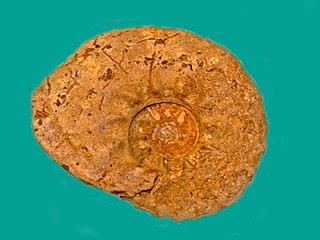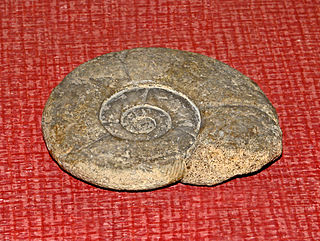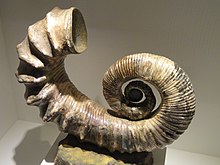
Ammonoids are extinct spiral shelled cephalopods comprising the subclass Ammonoidea. They are more closely related to living coleoids than they are to shelled nautiloids. The earliest ammonoids appeared during the Devonian, with the last species vanishing during or soon after the Cretaceous–Paleogene extinction event. They are often called ammonites, which is most frequently used for members of the order Ammonitida, the only living group of ammonioids from the Jurassic up until their extinction.

Acanthohoplites is an extinct genus of ammonites in the family Parahoplitidae that lived in the Aptian and Early Albian stages of the Early Cretaceous.
Aioloceras is an ammonite, order Ammonitida, from near the end of the Early Cretaceous. The shell is compressed with the outer whorl covering much of the previous. Sides are slightly convex, converge toward a narrowly ached venter. Inner whorls have sharp falcoid ribs, outer are smooth. Umbilical tubercles are lacking. Similar related forms include Neosaynella and Cleoniceras.
Ammonitoceras is an extinct genus of cephalopod belonging to the ammonite subclass that lived during the latter part of the Early Cretaceous in what is now Europe and the transcaspian region. Ammonitoceras was named by Dumas, 1876, the type-species: Ammonitoceras ucetiae. Although the description doesn't mention a hook, as in Ancyloceras or Acrioceras, Ammonitoceras is included in the Ancyloceratidae. However neither do Australiceras or Tropaeum, which are also included.
Astiericeras is an ammonite from the Lower Cretaceous, the shell of which is evolute, stout; outer whorl with strong, well spaced, transverse ribs that cross smoothly over the broad venter; early whorls with lateral tubercles. The outer, mature whorl separates from the coil but hooks back quickly, referred to as a heteromorph.

Astieridiscus is an extinct lower Cretaceous ammonite. Its shell evolute, covered by dense, simple or branching, slightly flexuous ribs. The sides are slightly flattened, the venter rounded. No umbilical or other tubercles except on innermost whorl. Superficially resembles Olcostephanus.

Argonauticeras is an extinct ammonoid cephalopod genus that lived during the latter part of the Early Cretaceous, included in the Lytoceratida and found in lower and possibly middle Aptian marine sediments. It has been thought of as a subgenus of Ammonoceratites.

Barremites is an ammonoid cephalopod genus belonging to the family Desmoceratidae, that lived during the Hauterivian and Barremian stages of the Early Cretaceous.

Barroisiceras is an acanthoceratacean ammonite from the Upper Cretaceous, Coniacian, included in the family Collignoniceratidae.
Anisoceratidae is an extinct family of heteromorph ammonites which belong to the Ancyloceratina superfamily Turrilitoidea. Members of the family range is from the lower Albian to the upper Turonian. The family is possibly derived from a member of the Hamitidae.
Phaulostephanus is an extinct genus from the ammonoid family Stephanoceratidae, which is part of the ammonitid superfamily Stephanoceratoidea, that lived during the early Middle Jurassic.

Discoscaphites is an extinct genus of ammonite. This genus may have been one of the few to have briefly survived the K-Pg mass extinction.

Hoploscaphites is an extinct ammonite genus from the Upper Cretaceous and the Lower Paleocene, included in the family Scaphitidae.
Neoptychites is an extinct ammonoid cephalopod genus from the Turonian stage of the Upper Cretaceous, with a worldwide distribution.

Craspedites is an ammonoid cephalopod included in the Perisphinctoidea that lived during the Late Jurassic and Early Cretaceous, found in Canada, Greenland, Poland, and the Russian Federation.

Hypophylloceras is a Cretaceous ammonite with a finely ribbed, compressed, involute shell; some having periodic stronger ribs or folds. The suture is complex, with large, asymmetric and finely divided lobes; the 1st lateral being much larger than the external (=ventral) and 2nd lateral lobes. Saddle endings commonly not phylloid.

Lytoceratinae is a subfamily of ammonoid cephalopods that make up part of the family Lytoceratidae.

Neocomites is a genus of ammonite from the Lower Cretaceous, Berriasian to Hauterivian, and type genus for the Neocomitidae.

Puzosia is a genus of desmoceratid ammonites, and the type genus for the Puzosiinae, which lived during the middle part of the Cretaceous, from early Aptian to Maastrichtian. Sepkoski defines the range from Albian to Santonian. The generic name comes from the Serbian words "Puž" (snail) and "oce/ose" (axis), gaining its name from the shell's snail-like appearance.
Melchiorites is a desmoceratid ammonite genus included in the subfamily Puzosiinae. Member species are characterized by an essentially evolute shell in which the early whorls are smooth, with sinuous radial or oblique constrictions but in which later whorls have feeble intermediate ribs on the outer part of the sides and venter.














